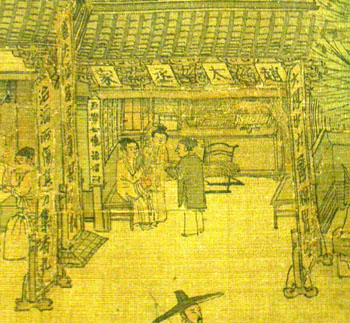HOW IT EVOLVED IN HISTORY
CASE 2: Medicine and Childbirth
| The earliest known records of healing activities in China are found on “oracle bones” dating from the thirteenth century BC. During this time, a king would use oracle bones to seek advice from the gods. A diviner would carve a question onto a tortoise shell or the shoulder bone of a cow and then heat it. After the bone cracked, he would interpret the cracks and inform the king what the gods had said. The types of questions that a king might ask ranged from “Is it a good time to go to war?” to “Will the rain come and save our crops?” Many of the oracle bones also were used to divine questions about medical matters, such as “Which angry ancestral spirit has caused the king’s toothache?” or “Will the queen bear a son?” These early records indicate that people at that time already had definite ideas about what caused disease and how to prevent or cure it.
At some point, people began to record their ideas about medicine, creating books that people could use to take care of themselves or others. The earliest known medical texts were excavated from a series of Chinese tombs constructed during the fourth to second centuries BC. These tombs were built for Chinese aristocrats and contained objects that they could use in the afterlife. These objects included medical texts written on strips of bamboo or on pieces of silk. One book, for example, described exercises that people could use to keep themselves healthy. Other books listed different illnesses and how to cure them, and other books taught people how to predict whether a patient would get better or die. Scholars are still trying to discern who wrote these early texts and how widely they were used. We know that many doctors wrote secret books that they shared only with their disciples. But some of these texts also became public knowledge. Some time beginning in the second century BC, a collection of writings by many different doctors was gradually edited into the most famous medical book, The Yellow Emperor’s Inner Canon. The book’s explanations of how the body works still serve as the foundation of traditional Chinese medicine today. It is no exaggeration to say that The Yellow Emperor’s Inner Canon is as important to Chinese medicine as the Bible is to Christianity. Just as there were historically many different interpretations of the Bible, there were also many different ways that doctors interpreted and used ideas from The Yellow Emperor’s Inner Canon.Zhang Zhongjing (ca. 150–219 AD), for example, wrote a famous treatise to explain his theory that a chief cause of disease was injury from cold. These early texts included discussions on childbirth and medical problems specific to women. Over time, medical explanations of women’s diseases became more numerous, detailed, and systematic. For example, when Sun Simiao (ca. 581-682 AD) wrote his medical textbook Prescriptions Worth a Thousand Gold Pieces, he explained that women needed specific treatments. One reason was that many medical problems were associated with women because they experienced childbirth. Sun also placed his discussion of women’s diseases at the begining of his book, because he thought that childbirth was the foundation of human society and therefore the most important issue for doctors to know about. A century and a half later, Zan Ying wrote the Treasury of Childbirth (852 AD), which is one of the earliest specialized works on what doctors called “childbirth medicine.” During the Song Dynasty (960–1279 AD), male scholars took an ever greater interest in medicine. This eventually made possible a great expansion in medical writing, including specialized writings on women’s medicine. |
|
Mother receiving medical care for her child at the doctor’s office.
|
To learn more about global medical practices and exchanges medical during the 18th century, check out GLOBAL CONTEXT |


